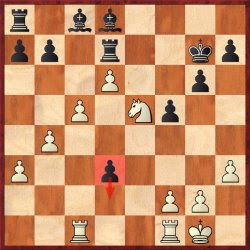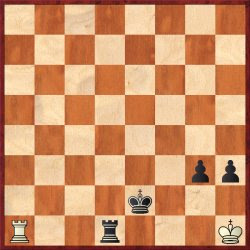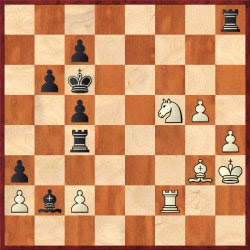 Kukov,Velislav (2373) - Bojkov,Dejan (2477) [E90]Blagoevgrad BUL, 73rd Men Ch R-13 Blagoevgrad BUL (13.2), 22.02.2009
Kukov,Velislav (2373) - Bojkov,Dejan (2477) [E90]Blagoevgrad BUL, 73rd Men Ch R-13 Blagoevgrad BUL (13.2), 22.02.2009This game was played in the final round of the Bulgarian Individual Championship. Boris Chatalbashev was leading with 10/12, I was second with 9, third was Momchil Nikolov with 8, and the fourth- Julian Radulski had 7 points. The spiciness of the situation was the fact that in all the players that were chasing the one in front of them had better tie-breaks. This meant that in case of a win, I could hope for the title (in case that Chatalbashev loses). On the other hand, a possible loss could send me to the third place. I needed to play for a win with maximum stability. The exchanged line of the KID did not bother me.
1.d4 Nf6 2.Nf3 g6 3.c4 Bg7 4.Nc3 0–0 5.e4 d6 6.h3 e5 7.dxe5 dxe5 8.Qxd8 Rxd8 9.Bg5 Na6 10.Nd5 Rd6 11.Bxf6 Bxf6 12.Rc1 Bd8 13.c5 Re6 14.a3 Kg7 A very useful prophylactic move. The king goes away from the possible pin on the a2-g8 diagonal, thus preparing f7-f6 or f7-f5 advances. [14...c6 is also logical. However, after: 15.Bxa6 it is better for Black to capture the knight, rather than the bishop, as the following game shows: (15.Ne3 b6 Ѕ–Ѕ Grivas,E (2475)-Kotronias,V (2610)/Karditsa 1996/CBM 053 16.cxb6 axb6 17.Bc4 Re8 18.Bxa6 Bxa6 19.Rxc6 Bb7 20.Rc4і 1/2 Grivas,E (2505)-Mozetic,D (2585)/Karditsa 1994/CBM 043) 15...bxa6 (№15...cxd5 16.Bd3 Re7 17.0–0 Bd7=) 16.Ne3 see the game 1–0 Arnaudov,P (2195)-Urukalovic,R (2273)/Zadar CRO 2008 (48)] 15.b4 [15.h4?! does not promise anything for White- 15...c6 16.Bxa6 (16.Ne3 b6 17.Bc4 White wins a pawn, but the powerful bishops an the insecure position of the enemy king provide more than sufficient compensation to Black. 17...Re7 18.Bxa6 Bxa6 19.cxb6 axb6 20.Rxc6 Bb7 21.Rc4 b5 22.Rc5 Bxe4 23.Rxb5 (23.Rxe5 Ba5+ with the idea- 24.b4 Rxe5 25.Nxe5 Bc7 with big advantage for Black) 23...Rc8 and Black does not have to complain at all) 16...cxd5 17.Bd3 dxe4 (17...Re7!?) 18.Bxe4 f5 19.Bd5 Re7 20.Ke2 And White already experienced difficulties, since the line: (20.0–0 e4 21.Nd4 Re5 22.Bb3 Bxh4 loses a pawn (Ilincic)) 20...e4 21.Nd2 Re5 and Black was already better in Grivas,E (2505)-Ilincic,Z (2530)/Varna 1994/EXT 1997 (33); 15.Ne3!? is worth a try in a practical game. Now: 15...c6 can transpose, but (15...Nb8 is an interesting alternative- 16.Bc4 (16.h4 Nc6 17.Bc4 Re8 18.h5 Nd4ѓ) 16...Re8 17.0–0 f6 18.Rfd1 c6= should give good play to Black.) 16.Bc4 (16.Bxa6 bxa6 transposes to Arnaudov,P (2195)-Urukalovic,R (2273)/Zadar CRO 2008 (48), where the rook on e6 was a target for the white knights.) 16...Re7 17.Bxa6 bxa6 18.Nc4 Bc7 19.Kd2 a5 20.Kc3 Ba6 21.Nfd2 Rb8 22.Rhd1 a4= is a line given by Ilincic in the Chess Informant.] 15...c6 16.Bxa6 cxd5 17.Bd3 Re7 18.0–0 f5
A very useful prophylactic move. The king goes away from the possible pin on the a2-g8 diagonal, thus preparing f7-f6 or f7-f5 advances. [14...c6 is also logical. However, after: 15.Bxa6 it is better for Black to capture the knight, rather than the bishop, as the following game shows: (15.Ne3 b6 Ѕ–Ѕ Grivas,E (2475)-Kotronias,V (2610)/Karditsa 1996/CBM 053 16.cxb6 axb6 17.Bc4 Re8 18.Bxa6 Bxa6 19.Rxc6 Bb7 20.Rc4і 1/2 Grivas,E (2505)-Mozetic,D (2585)/Karditsa 1994/CBM 043) 15...bxa6 (№15...cxd5 16.Bd3 Re7 17.0–0 Bd7=) 16.Ne3 see the game 1–0 Arnaudov,P (2195)-Urukalovic,R (2273)/Zadar CRO 2008 (48)] 15.b4 [15.h4?! does not promise anything for White- 15...c6 16.Bxa6 (16.Ne3 b6 17.Bc4 White wins a pawn, but the powerful bishops an the insecure position of the enemy king provide more than sufficient compensation to Black. 17...Re7 18.Bxa6 Bxa6 19.cxb6 axb6 20.Rxc6 Bb7 21.Rc4 b5 22.Rc5 Bxe4 23.Rxb5 (23.Rxe5 Ba5+ with the idea- 24.b4 Rxe5 25.Nxe5 Bc7 with big advantage for Black) 23...Rc8 and Black does not have to complain at all) 16...cxd5 17.Bd3 dxe4 (17...Re7!?) 18.Bxe4 f5 19.Bd5 Re7 20.Ke2 And White already experienced difficulties, since the line: (20.0–0 e4 21.Nd4 Re5 22.Bb3 Bxh4 loses a pawn (Ilincic)) 20...e4 21.Nd2 Re5 and Black was already better in Grivas,E (2505)-Ilincic,Z (2530)/Varna 1994/EXT 1997 (33); 15.Ne3!? is worth a try in a practical game. Now: 15...c6 can transpose, but (15...Nb8 is an interesting alternative- 16.Bc4 (16.h4 Nc6 17.Bc4 Re8 18.h5 Nd4ѓ) 16...Re8 17.0–0 f6 18.Rfd1 c6= should give good play to Black.) 16.Bc4 (16.Bxa6 bxa6 transposes to Arnaudov,P (2195)-Urukalovic,R (2273)/Zadar CRO 2008 (48), where the rook on e6 was a target for the white knights.) 16...Re7 17.Bxa6 bxa6 18.Nc4 Bc7 19.Kd2 a5 20.Kc3 Ba6 21.Nfd2 Rb8 22.Rhd1 a4= is a line given by Ilincic in the Chess Informant.] 15...c6 16.Bxa6 cxd5 17.Bd3 Re7 18.0–0 f5

This is better version of the game Kapnisis- Kotronias where Black had his king on g8, but still quite unclear. If Black wants save equality, he can opt for: [18...dxe4 19.Bxe4 f5 20.Bd5 e4 21.Nd4 Re5 22.Bb3 Bf6=]
19.exd5 e4 20.d6 Rd7 I felt that this is the best choice. [20...Rf7 21.Ne5 a) 21.Bxe4 fxe4 22.Ne5 Rf5; b) 21.Bc4! exf3 22.Bxf7 Kxf7 (22...fxg2? 23.Rfd1) 23.b5 Bg5 24.Rc2 Bd7 25.c6 bxc6 26.bxc6 Rc8 27.h4!

27...Bxh4 28.Rfc1 Be6 29.Rb1 fxg2 30.Rb7+ Kg8 31.d7+-; 21...exd3 22.b5 (22.Nxf7 Kxf7 23.Rfd1 Bg5 24.Rc3 Bd7 (24...d2 25.g3 Bd7 26.f4 Bf6 27.Rd3 a5) ) 22...Rf8 23.d7 d2 24.Rc2 Ba5 25.c6]
21.Ne5 During the game I mainly studied- [21.Bxe4 fxe4 22.Ne5 Bf6 23.Nxd7 Bxd7 24.Rfe1 Bc6 when white passed pawns are blocked, and Black already threatens to start picking them up.; 21.Bb5 exf3 22.Bxd7 fxg2 23.Kxg2 Bxd7 is much better for Black]
21...exd3 22.b5 d2
22.b5 d2 [Clearly worse is- 22...Ba5 23.Nc4 Bd8 24.c6 (24.Rfd1!?; If White wants a draw he can repeat the moves-24.Ne5=) 24...bxc6 25.bxc6 Rf7 26.Rfd1 Ba6 27.Ne5 and White is on top]
23.Rc2 Bf6 I disliked that in the lines starting with: [23...Bg5 24.f4?! (Better is 24.h4!? Bxh4 (24...Bf4? 25.Nxd7 Bxd7 26.c6 bxc6 27.bxc6 Be6 28.d7 Bc7 29.Rxd2+-) 25.Rxd2 with advantage) 24...Bxf4 25.Nxd7 Bxd7 26.c6 bxc6 27.bxc6 Rc8? (Instead of this Black must play 27...Be6 28.d7 Kf6 which leads to almost won position) 28.cxd7 the d8 square is not protected and Black loses an exchange.]
24.f4 This looks like a mistake to me now. In the line- [24.Nxd7 Bxd7 25.c6 Rc8! 26.c7 Bxb5 Black wins the pawn, but the computer shows that the things are far away from clear- 27.Rb1 Bg5 It looks like that Black should play the complicated position after: (27...Bd7 28.Rxd2 b5 and it is very unclear) 28.h4 Bf4 29.g3 Bxd6 (29...Ba4 30.d7 (30.gxf4 Bxc2 31.d7 Bxb1 32.d8Q leads also to an edge for White) 30...Bxd7 31.gxf4 Bc6 32.Rxd2 Rxc7) 30.Rxd2 Rxc7 31.Rxb5 Bxa3 32.Rbd5±]
24...Rd8 25.Rxd2 Bxe5 26.fxe5 Bd7  27.e6
27.e6 [27.a4 Kf7 is simply bad]
27...Bxe6 28.c6 Rac8 [28...bxc6 29.bxc6 Rac8 30.Rc1 Bd7 31.c7 Re8 could have kept the bishop alive.]
29.Re1 [29.Rc1 Bd7 30.Rdc2 bxc6 31.bxc6 Be8 32.d7 Bxd7 33.cxd7 Rxc2 34.Rxc2 Rxd7 is also great for Black]
29...Kf7 And not: [29...Kf6? 30.d7 Rc7 31.Rd6+-]
30.d7 Rc7 31.Rde2 Bxd7 32.Re7+ Kf6 33.cxd7 Playing for mate fails- [33.Rxh7 bxc6 34.Ree7 cxb5 35.h4 Rc1+ 36.Kh2 Be6]
33...Rdxd7
I managed to emerge a pawn ahead from the complications. However, a rook endgame always gives a lot of drawing chances for the defender.
34.R7e6+ Kg5 35.b6?! White wants to exchange both the pawns on the queen's flank, but he lacks the time. [35.R1e2 securing the second rank should have been preferred.]
35...axb6 36.Rxb6 Rc2 37.Re3 [37.Rb3 Rdd2 38.Rg3+ Kf6–+]
37...Rd1+ 38.Kh2 f4–+  39.Rf3 Rdd2 40.Rb5+ Kh6 41.Rxf4 Rxg2+ 42.Kh1 Rh2+ 43.Kg1 Rxh3 44.a4 Rc7 45.Rfb4
39.Rf3 Rdd2 40.Rb5+ Kh6 41.Rxf4 Rxg2+ 42.Kh1 Rh2+ 43.Kg1 Rxh3 44.a4 Rc7 45.Rfb4 Somewhere around here Chatalbashev resigned against his young opponent, which meant that a win will give me the title. This is the reason why the realization of the advantage took that long.
45...Ra3 46.Rh4+ Kg7 47.Rhb4 Rc1+ 48.Kg2 Rc2+ 49.Kg1 Ra1+ 50.Rb1 Rxa4 51.Rxb7+ Kh6 52.R7b5 Rg4+ 53.Kf1 Rg5 54.Rb7 Rf5+ 55.Kg1 Rfc5 56.R1b4 R2c4 57.Rb3 Rc1+ 58.Kg2 R5c2+ 59.Kg3 Rc3+ 60.Rxc3 Rxc3+ 61.Kf4 Rc4+ 62.Ke5 Rc5+ 63.Kf4 g5+ 64.Kg4 Rc4+ 65.Kg3 Rc6 66.Ra7 Kg6 67.Ra5 h5 68.Rb5 Rc3+ 69.Kg2 h4 70.Ra5 Kh5 71.Ra4 Rc2+ 72.Kh1 h3 73.Rb4 g4 74.Ra4 Kh4 75.Rb4 Re2 76.Ra4 Kg3 77.Ra3+ Kf4 78.Ra8 Kf3 79.Rf8+ Kg3 80.Rf1 Re4 81.Ra1 Kh4 82.Rb1 g3 83.Kg1 Kg4 84.Kh1 Rd4 85.Ra1 Rd3 86.Rb1 Kf3 87.Re1 Kf2 88.Rg1 Ke2 89.Ra1 Rd1+  0–1
0–1And this was it, I claimed my first Bulgarian national title in the classical chess.
 The black knight is stuck and dominated in the corner, nevertheless both hanging white pieces make it hard to take a direct advantage of it: 1.Ba4? cxb4 2.c5 b3 3.Bxb3 Nxb3 4.c6 Na2 5.c7 Nc6+ 6.Kd6 Na7=and white is one tempo short from his goal while 1.Na6? Kxd1 2.Nxc5 Nc2 3.Na6 Ne3 4.c5 Nc4+ 5.Kd5 Na5 is a simple book draw. Much more creative thinking is therefore required here: 1.Nc2! Nb3 Hoping for 2.Ne3? Na5! 3.Ke4 Nxc4! however... 2.Na1!! The knights exchange places and the capture now is forced in view of 2...Na5 3.Nb3+! 2...Nxa1
The black knight is stuck and dominated in the corner, nevertheless both hanging white pieces make it hard to take a direct advantage of it: 1.Ba4? cxb4 2.c5 b3 3.Bxb3 Nxb3 4.c6 Na2 5.c7 Nc6+ 6.Kd6 Na7=and white is one tempo short from his goal while 1.Na6? Kxd1 2.Nxc5 Nc2 3.Na6 Ne3 4.c5 Nc4+ 5.Kd5 Na5 is a simple book draw. Much more creative thinking is therefore required here: 1.Nc2! Nb3 Hoping for 2.Ne3? Na5! 3.Ke4 Nxc4! however... 2.Na1!! The knights exchange places and the capture now is forced in view of 2...Na5 3.Nb3+! 2...Nxa1  What have we got here? it is in fact the initial position just with the absence of the hanging knight on b4! This tiny difference finally paves white's way to an easy victory. 3.Ba4 Kc3 4.Kd5 Kb4 5.Bd1!
What have we got here? it is in fact the initial position just with the absence of the hanging knight on b4! This tiny difference finally paves white's way to an easy victory. 3.Ba4 Kc3 4.Kd5 Kb4 5.Bd1!  And in this reciprocal Zugzwang it's black to play...and lose! 1–0
And in this reciprocal Zugzwang it's black to play...and lose! 1–0
 A very useful prophylactic move. The king goes away from the possible pin on the a2-g8 diagonal, thus preparing f7-f6 or f7-f5 advances. [14...c6 is also logical. However, after: 15.Bxa6 it is better for Black to capture the knight, rather than the bishop, as the following game shows: (15.Ne3 b6 Ѕ–Ѕ Grivas,E (2475)-Kotronias,V (2610)/Karditsa 1996/CBM 053 16.cxb6 axb6 17.Bc4 Re8 18.Bxa6 Bxa6 19.Rxc6 Bb7 20.Rc4і 1/2 Grivas,E (2505)-Mozetic,D (2585)/Karditsa 1994/CBM 043) 15...bxa6 (№15...cxd5 16.Bd3 Re7 17.0–0 Bd7=) 16.Ne3 see the game 1–0 Arnaudov,P (2195)-Urukalovic,R (2273)/Zadar CRO 2008 (48)] 15.b4 [15.h4?! does not promise anything for White- 15...c6 16.Bxa6 (16.Ne3 b6 17.Bc4 White wins a pawn, but the powerful bishops an the insecure position of the enemy king provide more than sufficient compensation to Black. 17...Re7 18.Bxa6 Bxa6 19.cxb6 axb6 20.Rxc6 Bb7 21.Rc4 b5 22.Rc5 Bxe4 23.Rxb5 (23.Rxe5 Ba5+ with the idea- 24.b4 Rxe5 25.Nxe5 Bc7 with big advantage for Black) 23...Rc8 and Black does not have to complain at all) 16...cxd5 17.Bd3 dxe4 (17...Re7!?) 18.Bxe4 f5 19.Bd5 Re7 20.Ke2 And White already experienced difficulties, since the line: (20.0–0 e4 21.Nd4 Re5 22.Bb3 Bxh4 loses a pawn (Ilincic)) 20...e4 21.Nd2 Re5 and Black was already better in Grivas,E (2505)-Ilincic,Z (2530)/Varna 1994/EXT 1997 (33); 15.Ne3!? is worth a try in a practical game. Now: 15...c6 can transpose, but (15...Nb8 is an interesting alternative- 16.Bc4 (16.h4 Nc6 17.Bc4 Re8 18.h5 Nd4ѓ) 16...Re8 17.0–0 f6 18.Rfd1 c6= should give good play to Black.) 16.Bc4 (16.Bxa6 bxa6 transposes to Arnaudov,P (2195)-Urukalovic,R (2273)/Zadar CRO 2008 (48), where the rook on e6 was a target for the white knights.) 16...Re7 17.Bxa6 bxa6 18.Nc4 Bc7 19.Kd2 a5 20.Kc3 Ba6 21.Nfd2 Rb8 22.Rhd1 a4= is a line given by Ilincic in the Chess Informant.] 15...c6 16.Bxa6 cxd5 17.Bd3 Re7 18.0–0 f5
A very useful prophylactic move. The king goes away from the possible pin on the a2-g8 diagonal, thus preparing f7-f6 or f7-f5 advances. [14...c6 is also logical. However, after: 15.Bxa6 it is better for Black to capture the knight, rather than the bishop, as the following game shows: (15.Ne3 b6 Ѕ–Ѕ Grivas,E (2475)-Kotronias,V (2610)/Karditsa 1996/CBM 053 16.cxb6 axb6 17.Bc4 Re8 18.Bxa6 Bxa6 19.Rxc6 Bb7 20.Rc4і 1/2 Grivas,E (2505)-Mozetic,D (2585)/Karditsa 1994/CBM 043) 15...bxa6 (№15...cxd5 16.Bd3 Re7 17.0–0 Bd7=) 16.Ne3 see the game 1–0 Arnaudov,P (2195)-Urukalovic,R (2273)/Zadar CRO 2008 (48)] 15.b4 [15.h4?! does not promise anything for White- 15...c6 16.Bxa6 (16.Ne3 b6 17.Bc4 White wins a pawn, but the powerful bishops an the insecure position of the enemy king provide more than sufficient compensation to Black. 17...Re7 18.Bxa6 Bxa6 19.cxb6 axb6 20.Rxc6 Bb7 21.Rc4 b5 22.Rc5 Bxe4 23.Rxb5 (23.Rxe5 Ba5+ with the idea- 24.b4 Rxe5 25.Nxe5 Bc7 with big advantage for Black) 23...Rc8 and Black does not have to complain at all) 16...cxd5 17.Bd3 dxe4 (17...Re7!?) 18.Bxe4 f5 19.Bd5 Re7 20.Ke2 And White already experienced difficulties, since the line: (20.0–0 e4 21.Nd4 Re5 22.Bb3 Bxh4 loses a pawn (Ilincic)) 20...e4 21.Nd2 Re5 and Black was already better in Grivas,E (2505)-Ilincic,Z (2530)/Varna 1994/EXT 1997 (33); 15.Ne3!? is worth a try in a practical game. Now: 15...c6 can transpose, but (15...Nb8 is an interesting alternative- 16.Bc4 (16.h4 Nc6 17.Bc4 Re8 18.h5 Nd4ѓ) 16...Re8 17.0–0 f6 18.Rfd1 c6= should give good play to Black.) 16.Bc4 (16.Bxa6 bxa6 transposes to Arnaudov,P (2195)-Urukalovic,R (2273)/Zadar CRO 2008 (48), where the rook on e6 was a target for the white knights.) 16...Re7 17.Bxa6 bxa6 18.Nc4 Bc7 19.Kd2 a5 20.Kc3 Ba6 21.Nfd2 Rb8 22.Rhd1 a4= is a line given by Ilincic in the Chess Informant.] 15...c6 16.Bxa6 cxd5 17.Bd3 Re7 18.0–0 f5 






 There are other ideas for White in the position, but they does not seem harmful. B. Macieja introduced an interesting exchange sacrifice that he suggested in our game post-mortem in Greece 2005 (see bellow): [17.Nd5 Bxd5 (17...Be7 18.Nxe7+ Rxe7І is slightly better for White due to the pawn majority on the king's flank.) 18.Rxd5 Bd6
There are other ideas for White in the position, but they does not seem harmful. B. Macieja introduced an interesting exchange sacrifice that he suggested in our game post-mortem in Greece 2005 (see bellow): [17.Nd5 Bxd5 (17...Be7 18.Nxe7+ Rxe7І is slightly better for White due to the pawn majority on the king's flank.) 18.Rxd5 Bd6 







